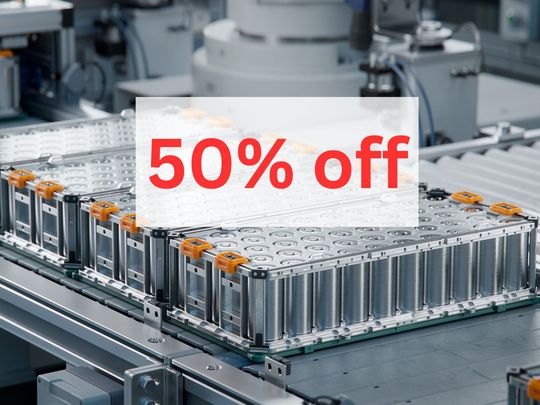
Highlights
- Price of 60 kWh battery pack seen falling from $6,776 to just $3,388 in only 12 months, saving over $3,000 per vehicle.
Are you intimidated by electric vehicle (EV) prices? It may not last that long. An anticipated plunge in lithium-iron-phosphate (LFP) battery prices – up to 50 per cent in 2024 – could herald a new era of EV affordability and accessibility.
This could have a knock-on effect, too, even for electric-powered air taxis.
In a major development, CATL has introduced new rectangular lithium iron phosphate (LFP) batteries which – unlike the more widely-used lithium ion (Li-ion) batteries – are not fire-prone.
It's an important move with far-reaching implicaitons. It is poised to drive down prices to less than $56 per kWh within the next six months, or before 2024 is out, according to industry media reports.
It's the power of Wright's Law at work: this framework used to estimate industrial costing suggests that for every cumulative doubling of units produced, costs tend to decrease at a constant rate.
CATL’s larger rectangular batteries equivalent to approximately six Tesla 4680 batteries each could make batteries, and eventually EVs, more affordable. Currently, the LFP battery price in China stands at $70 per kWh, according to industry data.
However, China's leading EV manufacturers, CATL and BYD, are aggressively targeting reductions of 0.1 rmb per watt-hour (approximately $14) per kWh, equating to substantial savings for a 60 kWh pack.
Outlook
With these concerted efforts, the price trajectory is set to plummet to $36 per kWh by the end of 2024, marking a remarkable decline from the $110-124 per kWh observed at the start of 2023.
For EV makers like Tesla, Kia and VW, this translates to immediate savings of about $2,000 in battery costs. And within the next few months, they stand to save $800 in LFP battery expenses, with an additional $800 expected within approximately 18 months.
The trend could also have far-reaching implications for the e-trucks and e-buses.
Battery production up
One evidence of the rising demand for further electrification, higher production and lower prices for battery components.
Due to oversupply, battery minerals have seen huge drops in price. Nickel, for example, opened 2023 at $31,238.53 per tonne (on January 2, 2023), then dropped nearly 50 per cent to $15,843 on November 26, 2023.
Production and refining capacity for nickel and lithium, two major battery components, have signficantly expanded globally, with billions in fresh investments in factories.
By December 2023, the nickel price largely fluctuated between $16,000 and $17,000 per tonne, before closing the year at $16,375, much lower than where it started. It stood at $17,178 as of February 23, 2024, according to Business Insider data.
Meanwhile, China’s lithium chemical output jumped in 2023, industry association data showed, as producers ramped up production to meet growing demand for the battery material.
Production capacity of lithium carbonate reached 1.1 million tonnes last year, up 83.3 per cent from 2022 to 2023, according to a post by the lithium branch of the China Nonferrous Metals Industry Association.
Reuters reported that the world's top lithium chemical producer made 517,900 metric tonnes of lithium carbonate last year, up 31.1 per cent from 2022.
Demand for the metal has been boosted by the energy vehicle and energy storage sectors, the two main consumers of lithium.
However, higher output weighed on lithium prices, with spot lithium carbonate in China falling more than 80 per cent over the previous year. China's lithium hydroxide output rose 30.1 per cent to 319,600 metric tons, the data also showed.
Tesla (primarily its Gigafactory in Shanghai), GAC's Aion, Li Auto, Geely, and Nio are the top customers of CATL, which accounted for 34 per cent of global EV battery production in 2022.
It also supplies batteries to Ford and Volkswagen. The company's advancements in battery technology include a high-energy-density 500Wh/kg battery.
Earlier, CATL has unveiled plans for a $7.48 billion investment in Hungary for its second European battery plant, aiming to be closer to customers and solidify its position as the top battery manufacturer. Thailand is also in talks with CATL to boost local battery production, its first Southeast Asian factory. Thailand offers tax incentives and subsidies to promote EV adoption, aiming for 30% by 2030. They provide subsidies of $2,057 to $4,409 per electric car produced.
Any moves by CATL will be closely watched by the other players, big and small.
The price trend tracks an earlier prediction by Bloomberg New Energy Finance (BNEF), a research outfit. In November 2023, it stated that average battery pack prices will drop to $133/kWh (in "real 2023 dollars").
The report identified key drivers: technological innovation and manufacturing improvements. BNEF expects battery prices to drop to $80/kWh in 2030.
BNEF's price forecasts may just need to be tweaked downward a little sooner. It's not hard to think of the ongoing battery price war helping accelerate the global transition to renewable transport.
• But Wright's Law, also known as the “learning curve effect”, is also at work, especially in batteries and EV production.
• Named after US engineer Theodore Paul Wright, it provides a framework for forecasting cost declines as a function of cumulative production.
• Wright's Law suggests that for every cumulative doubling of units produced, costs tend to decrease at a constant rate.








